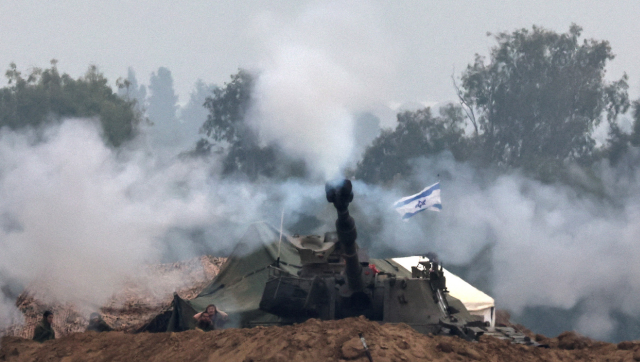After the United States used its UN Security Council veto to shield its ally from a demand for a ceasefire, Israel forced inhabitants out of Gaza’s largest southern city Khan Younis and bombarded the length of the territory overnight. Since the two-month-old war’s truce with Hamas fell apart on December 1, Israel has escalated its ground assault into the Gaza Strip’s southern half, moving into Khan Younis, where residents reported heavy clashes. Both parties claimed an increase in combat in the north. Israel said its campaign was making progress. National Security Adviser Tzachi Hanegbi said Israeli forces had killed at least 7,000 Hamas militants, without saying how that estimate was reached, and military chief Lieutenant-General Herzi Halevi told soldiers “we need to press harder”. On Saturday, the Palestinian health ministry said that the death toll in Gaza had surpassed 17,700, with many others still missing and assumed dead under the debris. According to the ministry, almost 40% of the deaths included youngsters under the age of 18. Israel initiated its effort to eliminate Gaza’s Hamas leadership after their fighters stormed Israeli cities on Oct. 7, murdering 1,200 people and kidnapping 240, according to Israeli estimates. 137 hostages are still being held captive, and thousands of Israelis marched in Tel Aviv on Saturday to demand their release. The Israeli army stated early Sunday that a soldier who battled on Oct. 7 died from his wounds, adding that four other troops died fighting in southern Gaza. Most of Gaza’s 2.3 million residents have been forced from their homes, often several times. As fighting rages across the territory, residents and UN agencies say there is effectively nowhere safe to go, though Israel disputes this. Israeli forces say they are limiting civilian casualties by providing maps showing safe areas, and blame Hamas for harming civilians by hiding among them, which the fighters deny. Palestinians say the campaign has turned into a scorched-earth war of vengeance against the entire population of an enclave as densely populated as London. Israel’s Arabic-language spokesperson on Saturday posted a map on X highlighting six blocks of Khan Younis to evacuate “urgently”. Some residents reported hearing tank shelling and fierce gun battles between Israeli forces and Palestinian fighters, and a series of air strikes as Israeli forces attempted to advance further west. “We try to put the children to sleep and we stay up fearing the place would be bombed and we’ll have to run carrying the children out,” said Zainab Khalil, 57, displaced with 30 relatives and friends near Jalal street where evacuations were ordered. “During the day begins another tragedy, and that is: how to feed the children?” With food and medical supplies scarce, a senior UN World Food Programme official said a new system could bring more aid into Gaza through the Kerem Shalom crossing with Israel, but Israel has not yet agreed to open it. In central Gaza, Israeli tank shelling resumed on Bureij and Maghazi refugee camps, residents said, while Palestinian health officials reported an Israeli air strike in Bureij killed seven Palestinians. In Khan Younis, the dead and wounded arrived through the night at the overwhelmed Nasser hospital. A medic ran out of an ambulance with the limp body of a small girl in a pink tracksuit. Inside, wounded children wailed and writhed on the tile floor as nurses raced to comfort them. Outside, bodies were lined up in white shrouds. Thousands missing presumed dead Footage obtained by Reuters inside the Jaffah hospital in Deir al-Balah showed extensive damage from a strike on a mosque next door that shuttered the medical facility. Medical workers in northern Gaza, where some of the heaviest fighting is taking place, accused Israel of targeting hospitals and ambulances. An ambulance worker in Gaza City’s Shejaiya district, asking not to be named for fear of reprisals, told Reuters emergency crews often could not respond to calls and faced Israeli fire. Mohammed Salha, a manager at al-Awda hospital, said Israeli forces had besieged the hospital for days with tanks, shooting people trying to enter or leave. The health ministry said Israeli forces killed two medical staffers inside Kamal Adwan hospital, also in northern Gaza, on Saturday. An Israeli military spokesperson said it follows international law and takes “feasible precautions to mitigate civilian harm”. The military has said Hamas operates from medical facilities, releasing footage to support that claim. Hamas has denied doing so. U.S. veto makes Washington ‘complicit’ Israeli Prime Minister Benjamin Netanyahu on Saturday welcomed Washington’s veto at the United Nations Security Council a day earlier to reject a vote backing a humanitarian ceasefire resolution, saying: “Israel will continue our just war to eliminate Hamas.” Washington has said it told Israel to do more to protect civilians but still backs Israel’s position that a ceasefire would benefit Hamas. On Saturday, the Biden administration bypassed the U.S. Congress to approve an emergency sale of ammunition to Israel. Ezzat El-Reshiq, a member of Hamas’ political bureau, condemned the U.S. veto as “inhumane”. Mahmoud Abbas, president of the Palestinian Authority which lost control of Gaza to Hamas in 2007, said the veto made the United States complicit in Israeli war crimes.
Palestinians report Israeli battles in Khan Younis after US blocks Gaza ceasefire call
FP Staff
• December 10, 2023, 10:53:04 IST
Since the two-month-old war’s truce with Hamas fell apart on December 1, Israel has escalated its ground assault into the Gaza Strip’s southern half, moving into Khan Younis, where residents reported heavy clashes
Advertisement
)
End of Article